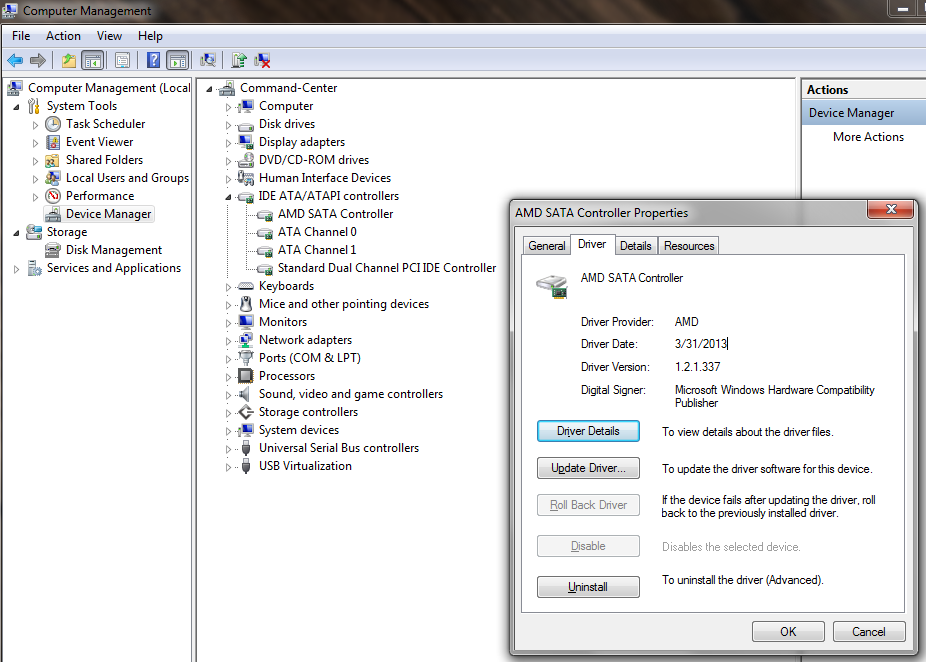Ahci Driver Windows 7 64 Bit

Gateway E-475M Notebook Intel SATA AHCI Driver 7.0.0.1020 for Win XP 32/64-bit Publisher's description from Gateway E-475M Notebook Intel SATA AHCI Driver 7.0.0.1020 for Win XP 32/64-bit It is highly recommended to always use the most recent driver version available. Do not forget to check with our site as often as possible in order to stay updated on the latest drivers, software and games.

Download Gigabyte Q1458P AHCI Driver v.8.9.0.1023 for Windows 7 (32/64-bit). Download is free of charge.
Try to set a system restore point before installing a device driver. This will help if you installed a wrong driver. Problems can arise when your hardware device is too old or not supported any longer. Woh rehne waali mehlon ki serial sad songs youtube.
When I built my current computer system in May 2011, I did not encounter this problem with installing 64-bit Windows 7 Pro on the new 500 GB Western Digital HDD. In fact, I installed Win7 three times (wiping the drive with DBAN after the first and second installs) before I was satisfied with the third install.
Prior to the first installation, I configured the Gigabyte GA-890FXA-UD5 motherboard BIOS (updated) for SATA AHCI (with SATA 3.0), and copied the AHCI driver from the Gigabyte CD onto a USB SanDisk Cruzer (4GB). The GA-890FXA-UD5 (revision 2.1, BIOS ver. F6) has an AMD chipset. During each install, the Win7 installer reported that it could not find a HDD and offered the option Load Driver. I used that option, and the installer displayed a dialog with which I browsed to the Cruzer to select the AHCI driver. Each time, the installer loaded the driver successfully without a hitch. Of course, I still have the Microsoft Windows 7 Pro installation DVDs, bought with a Full Retail License.
So: two years later, after I began encountering various problems for which I could find neither cause nor resolution, I suspected malware or Registry corruption. Otzivi rukovoditelya o rabotnike primera. To make a long story short, eventually I decided to wipe the internal HDD again, after backing-up the data files on an external USB HDD.
Now the Win7 installer follows the same routine, of course. Except that now it fails to load the AHCI driver from the SanDisk Cruzer (!).
I have also removed the Win7 installation DVD, loaded the Gigabyte CD, navigated to the driver and selected it. The Win7 installer still failed to load it.
Further, before running the Win7 installer for other attempts, I connected the external USB HDD, and navigated to an archived copy of the AHCI driver on it, but the Win7 installer failed to load it. I've made numerous and repeated attempts with every storage media at hand which contains a copy of the AHCI driver files, but no joy.
For what it is worth, I also ran the software on the Repair Disc that I made soon after installing Win7 Pro, and it failed to load the AHCI driver from the SanDisk Cruzer and from the Gigabyte CD, respectively. Then I reconfigured the motherboard BIOS for SATA IDE (with SATA 3.0), and rebooted the system. You might think that the Win7 installer would have an appropriate driver for the AMD SATA IDE since it has one for the Samsung DVD-Writer Optical Disk Drive (obviously), but it did not find a HDD.
So I navigated to the appropriate AMD x64 IDE driver files on the Gigabyte CD, but the installer failed to load that one, too. Question: why does the 64-bit Windows 7 Pro installer fail to install the AHCI driver, and what can I do about it? Hi, Thank you for posting your query on Microsoft Community. AHCI (Advanced Host controller) makes NCQ (Native Command Queing) along with hot-plugging or hot swapping through SATA Serial-ATA host controllers possible; Vista was the first to offer this feature.
The issue with AHCI is it needs to be enabled in the BIOS prior to OS installation; doing so after you have installed the OS will disable the PC. The reason why Windows disables the AHCI drivers not needed during installation. I would suggest you to enable AHCI after you have installed the OS if you didn't already have AHCI enable in the BIOS when you installed the OS. Disclaimer: This section, method, or task contains steps that tells you how to modify the registry. However, serious problems might occur if you modify the registry incorrectly. Therefore, make sure that you follow these steps carefully. For added protection, back up the registry before you modify it.